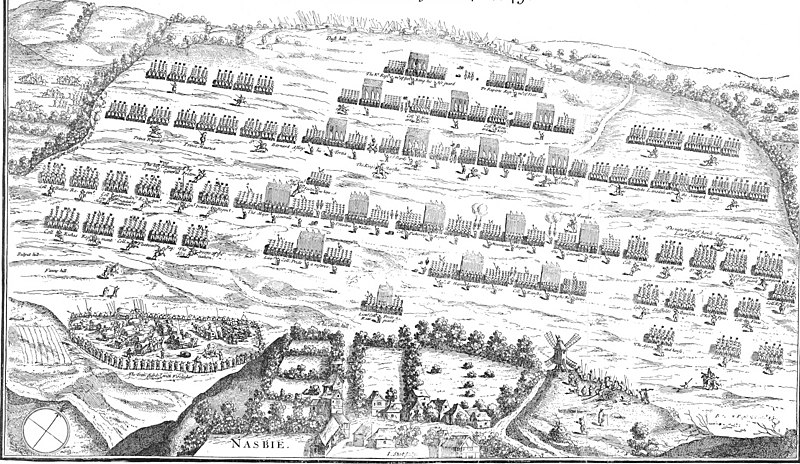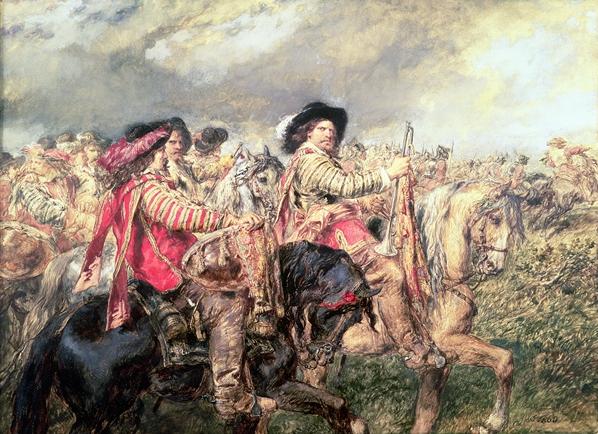written by Charis Gambon
The Battle of Naseby took place on 14thJune 1645 during the First English Civil War, near the village of Naseby in Northamptonshire in the open fields. The battle started in the morning on a foggy day at 10am. After almost three years of fighting, the Parliamentarian New Model Army which comprised of 14,000 men fought the Royalist army of King Charles I which comprised of less than 9,000 men, in what would be the final key battle of the civil war. Although Charles did not finally surrender until 1646.
During the battle, the Parliamentarian army overwhelmingly destroyed the Royalist army with the battle ending in a decisive victory for the new model army. Only about 4000 Royalists soldiers escaped the field, most of the men who managed to survive were either cavalry or senior officers, some of who were seriously wounded. The battle of Naseby was an incredibly significant battle as it marked an end to royalist victories.

The battle of Naseby was the first battle won by the New Model Army. This was because the new model army was formed in February 1645, which was four months before the battle. The new model army was formed as Parliament felt that a professional army would increase their odds of beating the King in battle. This design was evidently incredibly effective as the Royalist army never succeeded in winning another battle after Naseby and the creation of the New Model Army.
The Royalist army was led by Prince Rupert, King Charles was also present at the battle. While the Parliamentarian army was led by Sir Thomas Fairfax with Oliver Cromwell as the second in charge. The King’s forces were more experienced in battle than the newly formed New Model Army. However, they were formed with one specific goal in mind, and that was to destroy the King and his Royalist forces. At the battle of Naseby, the first decisive blow to the King and his army was given by the Parliamentarians with their win.
The battle originally started well for Charles and the Royalist army. Prince Rupert attacked the Parliamentarian left wing with a quick charge and the King’s pikemen and musketeers pushed Parliament’s infantry back almost to their breaking point. However, Rupert’s charge left his men scattered across the battle field and on the other flank, Royalist solider Marmaduke Langdale, was impeded by Parliament’s second in charge, Oliver Cromwell, with the Parliamentarian cavalry confronting the Royalist infantry. A running retreat by Royalist forces over 12 miles took place, with thousands of casualties and captures as a result.

The battle of Naseby destroyed King Charles’ veteran infantry force as many of the soldiers had been killed or captured by the opposing Parliamentarians. After Naseby, Charles spent the rest of his time before his surrender in 1646 being pursued and constantly beaten by the Parliamentarians and the New Model Army. Charles had very severely lost his advantage that he had held prior to the battle of Naseby. The summer of 1645 was particularly full of failures for the Royalist army and after the summer the Royalist army was well and truly broken. Although the King dragged out the war until 1646 out of a desperate feeling that he could still somehow win the English Civil War.
The battle of Naseby helped to demonstrate that the King was a failure and caused people to question whether Charles did actually possess the King’s divine right to rule England. Under the divine right of Kings, Charles had the right to call and dismiss Parliament as he saw fit. This system was clearly no longer respected as Parliament defeated the King and his forces at Naseby. The battle established Parliaments right to have a permanent role with England after Charles’ eleven years of not using Parliament.
As a result of the Parliamentarian victory, all the Royalist guns were taken with most of the supplies . King Charles I’s coach was captured with his correspondence, revealing damaging letters on his attempts to raise Catholic and Continental support for his cause. This Catholic correspondence was quickly published by the Parliament in a volume entitled ‘The King’s Cabinet Opened.’ The publishing of the letters did little to help the King as the general population of England were very against Catholicism and as a result support for the King decreased a significant amount.
The battle of Naseby helped to demonstrate the importance of Oliver Cromwell. That Cromwell realised the benefit of training his cavalry soldiers properly and effectively. He realised that if you trained your cavalry properly you could drive off the enemy incredibly easily, then get back into order quickly, and then wheel round and flank the enemy’s infantry again easily and quickly. Cromwell’s elite cavalry soldiers helped to turn any battle they fought into a win for the Parliamentarians.
Refrences:
https://www.historic-uk.com/HistoryMagazine/DestinationsUK/The-Battle-of-Naseby/
http://www.battlefieldstrust.com/resource-centre/civil-war/battleview.asp?BattleFieldId=51
https://www.historyhit.com/facts-about-the-battle-of-naseby/
https://www.britannica.com/topic/New-Model-Army
featured image courtesy of wiki commons. Image can be found here

